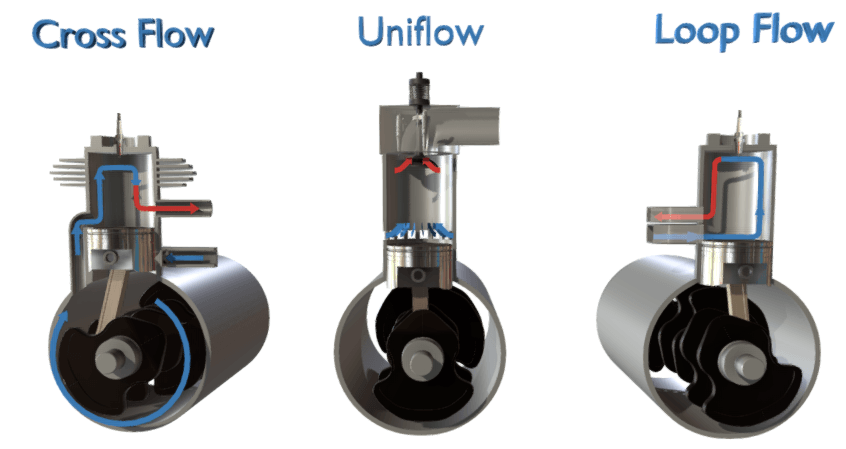Introduction
The process of admitting air into the combustion space is known as charging. The process of admitting air and expelling exhaust gas is known as scavenging. The three main types of scavenging for two stroke engines are cross flow, uniflow and loop flow.
Notice on the below image that the cross flow and loop flow scavenging designs use ports only, whilst the uniflow design uses valves (for exhaust) and ports (for inlet). Most diesel engines do not use uniflow scavenging, this design is for very large marine engines only.

Cross Flow, Loop Flow and Uniflow
Cross, Loop and Uniflow Scavenging Explained
What is the difference between a supercharger and turbocharger?
A turbocharger is a machine used to force air into the combustion space. The turbocharger has a turbine that rotates when exhaust gas passes over its blades. The turbine is on a common shaft with a compressor and this compresses more air (more oxygen for combustion) into the combustion space.
A supercharger is driven via gears directly from the engine, but serves the same purpose as a turbocharger (compress air prior to it entering the combustion space).
Because the turbocharger is driven by a waste product (exhaust gas), it increases the overall engine efficiency. A supercharger is driven from the engine, so it uses power that could have been used on the main drive, this makes it less efficient than a turbocharger.
What does 'charging mean'?
The terms turbocharger and supercharger refer to the process of forcing more air into the combustion space, which is effectively super or turbo charging.
What are 'parasitic' loads?
Loads on an engine are sometimes referred to as a 'parasitic' loads because they draw upon the power the engine creates and this power cannot be delivered to the main drive e.g. a cooling water pump, alternator and supercharger are examples of parasitic loads.
Enjoying this article? Then be sure to check out our Internal Combustion Engines Video Course! The course has a quiz, handbook, and you will receive a certificate when you finish the course. Enjoy
Related Online Engineering Courses
Internal Combustion Engine Basics
Diesel Engine Fundamentals (Part 1)
Diesel Engine Fundamentals (Part 2)
Crankcase Explosion Relief Valves Explained
Additional Resources
https://en.wikipedia.org/wiki/Scavenging_(automotive)
http://www.tpub.com/engine3/en32-1.htm
https://www.sciencedirect.com/science/article/abs/pii/0360128590900455